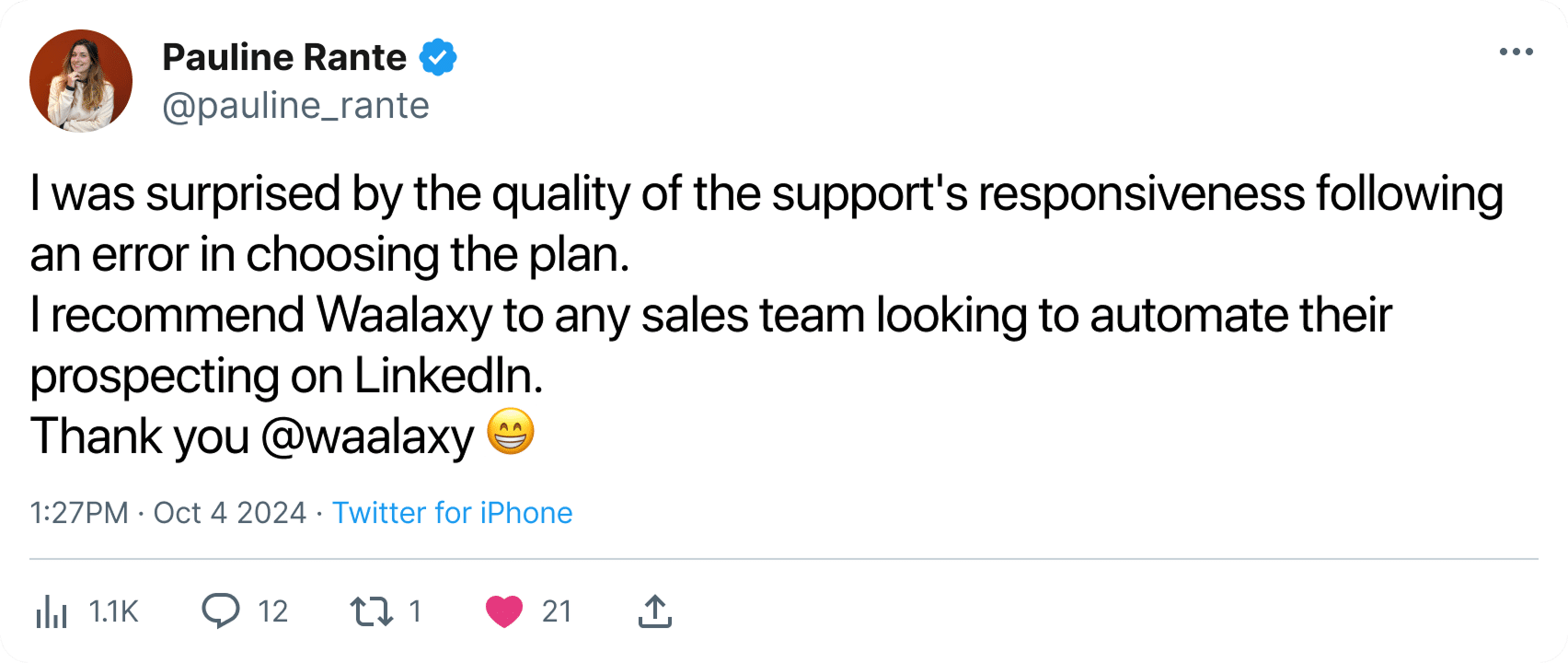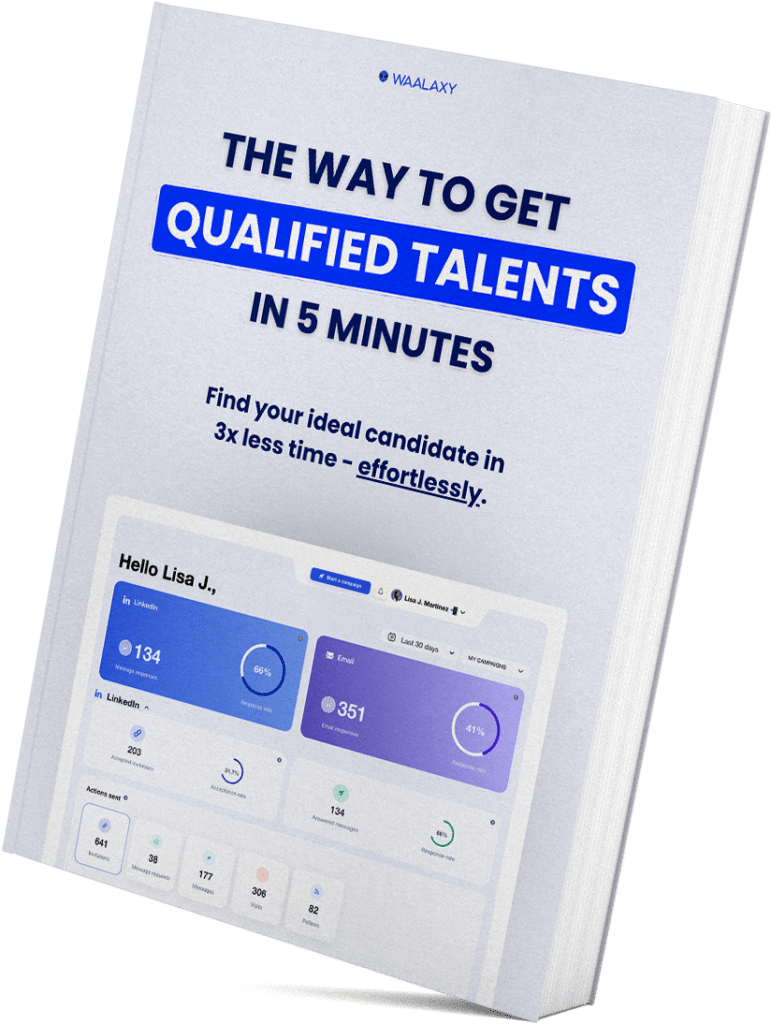I bet you’re wondering… What exactly is a cold email? ❄️
Or even:
- How can you launch a cold email campaign that really generates responses, leads, and appointments?
- What cold email templates could you use for your B2B prospecting strategy?
- How can you automate all of this without losing personalization? 😈
We’ll go over everything: definition, best cold email strategy, copywriting, tools, KPIs… Discover all these cold email expert tips and best practices in this ultimate cold email guide! 😎
What is cold emailing?
A cold email is an unsolicited professional email sent to someone with whom you have no prior relationship.
- You have never had any contact with and never interacted with before,
- Has not explicitly asked you to contact them,
- Whom you do not know and who does not know you (or barely).
In short, “cold emailing” means writing to a prospect “cold”, whom you do not know and for no apparent reason, to initiate a first relationship.
The goal is not to sell or tout the merits of your company, but rather to:
- Introduce yourself,
- Break the ice and create a first point of contact,
- Cold email to potential client to start a conversation to establish a relationship and learn more about them
- Guide them through the stages of your sales prospecting funnel (visit, response, appointment, demo, etc.).
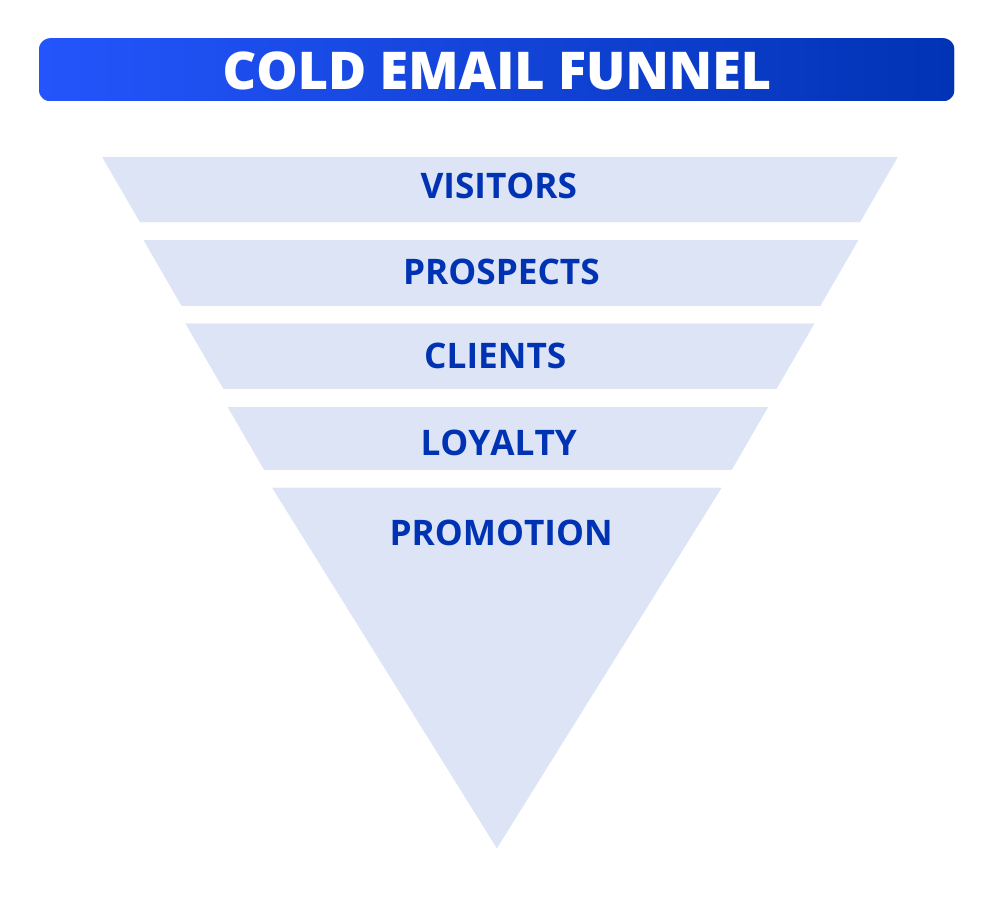
Cold emailing is done either via rented, purchased, or “scraped” databases, for which the collection method varies greatly, or from addresses collected by email enrichment, or even manually qualified.
It’s similar to cold calling… But less intrusive because it takes less time for the recipients, is more traceable, more qualified, and much more scalable when done right (targeted, useful, opt-in and opt-out, personalized content based on the target audience, etc.). 😎
Cold mailings are most often sent as part of an email marketing strategy.
It poses a marketing pressure problem and can lead to deliverability issues when misused (often encountered by growth hacking professionals). 😎
Not to be confused with spam (mass, untargeted, irrelevant mailings) or follow-up emails to leads who are already lukewarm or customers.
Finally, here are the main differences between cold email vs warm email vs spam (be careful, because it’s very easy to look like spam):
| Criteria | Cold | Warm | Spam |
|---|---|---|---|
| Personalized content. | ✅ | ✅ | ❌ |
| Honest approach. | ✅ | ✅ | ❌ |
| Sent to all types of audiences. | ❌ | ❌ | ✅ |
| Opt-in subscription & opt-out unsubscription. | ✅ | ✅ | ❌ |
| Sent from email domains. | ❌ | ❌ | ✅ |
| Sent under real names. | ✅ | ✅ | ❌ |
| Existing relationship. | ❌ | ✅ | ❌ |
| Message relevance. | ✅ | ✅ | ❌ |
| Prior engagement. | ❌ | ✅ | ❌ |
| Perceived as legitimate. | ✅ | ✅ | ❌ |
| Sending volume. | ❌ | ❌ | ✅ |
| Compliance with regulations. | ✅ | ✅ | ❌ |
What is cold email marketing?
Cold email marketing involves using these cold emails as a channel for acquisition and prospecting.
The idea is not to “spam” a purchased database, but to:
- Target an ICP (Ideal Customer Profile) or a very specific target audience (if necessary, divide into segments according to company type, job title, location, etc.),
- Build a list of qualified contacts with professional email addresses who are likely to be interested and take action,
- Send a structured sequence of personalized emails with an angle tailored to the segment (1st contact + follow-ups),
- Track responses, open rates, clicks, conversions,
- And continuously improve the campaign (A/B testing, message adjustments, etc.).
We’re not just talking about a single cold email, but rather a structured outreach strategy, often integrated into a multi-channel approach (LinkedIn + email + phone, etc.) and based on the quality of targeting, copywriting, iteration, and automation.
Some examples of segments:
– B2B SaaS companies with 11–200 employees,
– Marketing agencies working with e-commerce companies,
– HR departments in industry,
– Pre-seed/seed start-up founders.
Why is cold email outreach important?
Cold email remains one of the most effective acquisition levers in B2B, as it allows you to create a simple, quick, and non-intrusive first point of contact with a prospect.
It is an ideal channel for establishing relationships, developing your network, and initiating qualified conversations without relying on an algorithm or advertising budget.
Unlike other marketing solutions, cold email is extremely targeted and also offers exceptional scalability at a low cost if automated:
- Only target individuals who align with your ICP, show interest in your offer, or express a desire for information.
- Plan emails in advance and launch cold email campaigns to contact hundreds of qualified prospects per day.
- Maintain a high level of email personalization and response tracking.
- Strive to transform these prospects into valuable customers by gradually warming them up, not instantly, but gradually..
It is one of the most cost-effective channels for generating leads, booking calls, testing new markets… And exploding growth without exploding the budget (even with a small team).
How do you create a cold emailing campaign?
Let’s get down to business: how do you launch a well-structured and effective cold email campaign?
Before you get started and send any emails, here are a few tips to always follow to avoid the spam folder:
- Identify the category of the address from which you will be sending cold emails (good, bad, or spam email).
- Configure your domain/DNS (SPF, DKIM, DMARC) dedicated to prospecting correctly to get a good score.
- Warm up your domain/mailbox by gradually sending more emails.
- Finally, complete the VESV checklist.
Complete VESV checklist:
– Check your email’s spam score using an online mail tester, which will rate your email on a scale of 1 to 10 and suggest changes to improve it.
– Validate your prospect list.
– Establish a clear CTA ,
– Follow up with a follow-up email to your prospects (steps),
All these steps are essential to ensure that your cold email campaign (sequence) has a high email deliverability rate and that your message reaches your recipient’s inbox. 😨
Now that you know the prerequisites that will drastically increase your chances of getting past spam filters…
We can get to the heart of the matter and roll out our simple method for building an automated cold outreach campaign.
1. Define your ICP for effective targeting/segmentation
Before thinking about tools or sequences, you need to know who you are talking to.
The key to a successful campaign is your ICP (Ideal Customer Profile). Unlike the buyer persona, it does not focus on the psychological traits of the target but on the business criteria that make a person a good target.
The ICP must meet the following minimum requirements:
- What type of company? (sector, size, business model)
- What type of decision-maker? (position, hierarchical level, responsibilities)
- What specific problem and pain points are you solving for them?
- What size of company and type of stack?
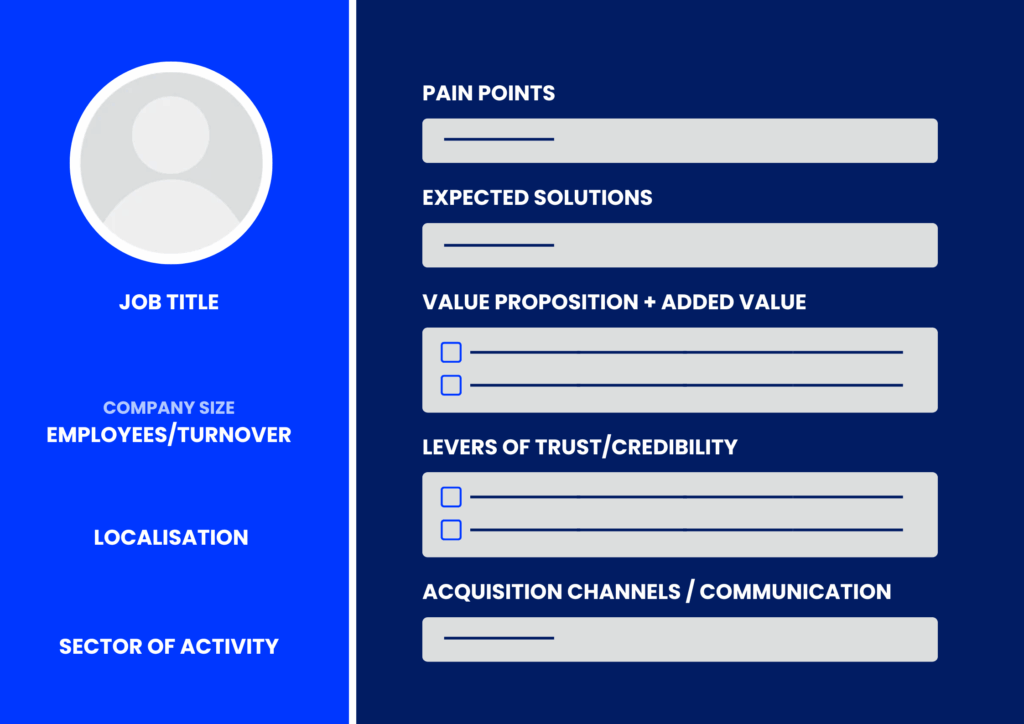
Examples:
“Marketing managers in B2B SaaS companies with 20-200 employees that already have an acquisition budget.”
“Founders of SEO agencies with +5 clients and a team of at least 3 people.”
The clearer your ICP is, the more:
- Your email lists will be clean,
- Your segmentation will be effective,
- Your messages will be relevant,
- Your results will be good (high open/response/conversion rates and profitable campaigns).
2. Import your prospects from LinkedIn to build a list
LinkedIn is the best and largest B2B database in the world, allowing you to retrieve free contacts interested in your offer to launch a B2B cold email campaign.
With a cold email software like Waalaxy, you can:
- Launch a LinkedIn (or Sales Navigator) search,
- Target your prospects according to your ICP,
- Auto-import these profiles into your prospecting CRM with one click (from searches, posts, groups, events, profile visits, etc.).
- Retrieve their key information (name, position, company, profile URL) in one click in qualified and well-structured lists.
- Automatically enrich their data to complete your prospect list.
- Combine cold LinkedIn messages and cold emails in a single personalized multichannel campaign.
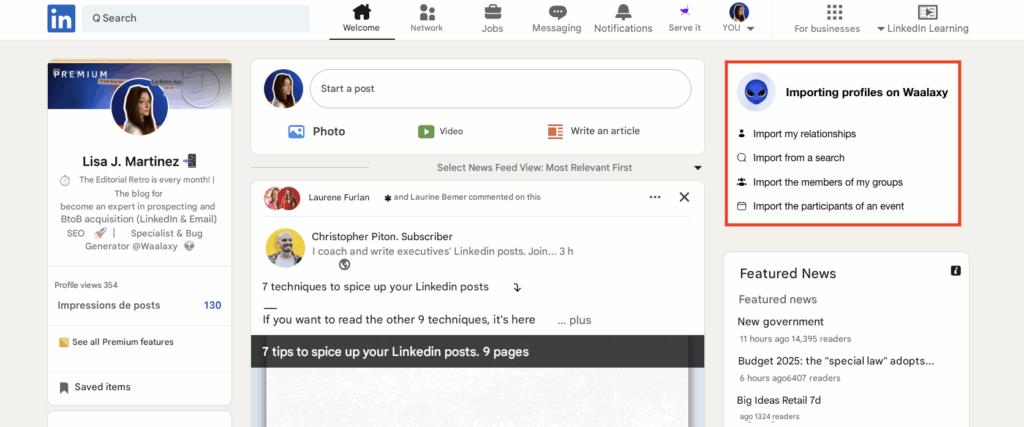
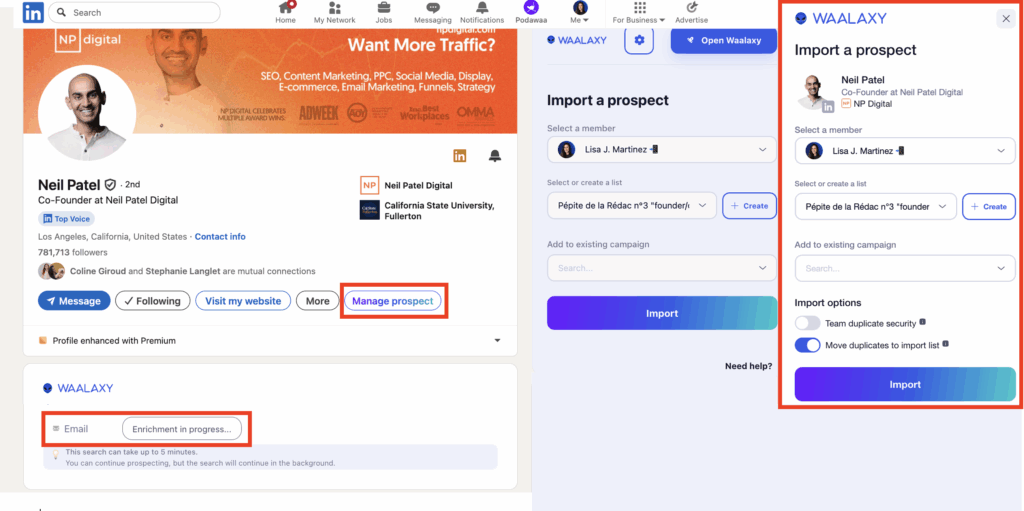
All without wasting time manually copying and pasting, without drowning in multiple CSV files, and with data that is always up to date!
3. Choose a sequence with Email Finder
Once your prospects have been imported, how to find emails for cold emailing? Choose a sequence of automated email campaigns containing an Email Finder.
For example, here is one that allows you to get the best rates and combine the best of both worlds (human connection on LinkedIn, email follow-up, then automated follow-up):
LinkedIn profile visit → Invitation or Message → Email Finder → Cold email → Email follow-up.
Email Finder will automatically search for and detect your prospects’ professional email addresses.
And Waalaxy’s is really the best for starting with a simple list of LinkedIn profiles and getting a database of validated professional emails ready for cold emailing in just a few minutes. 🔥
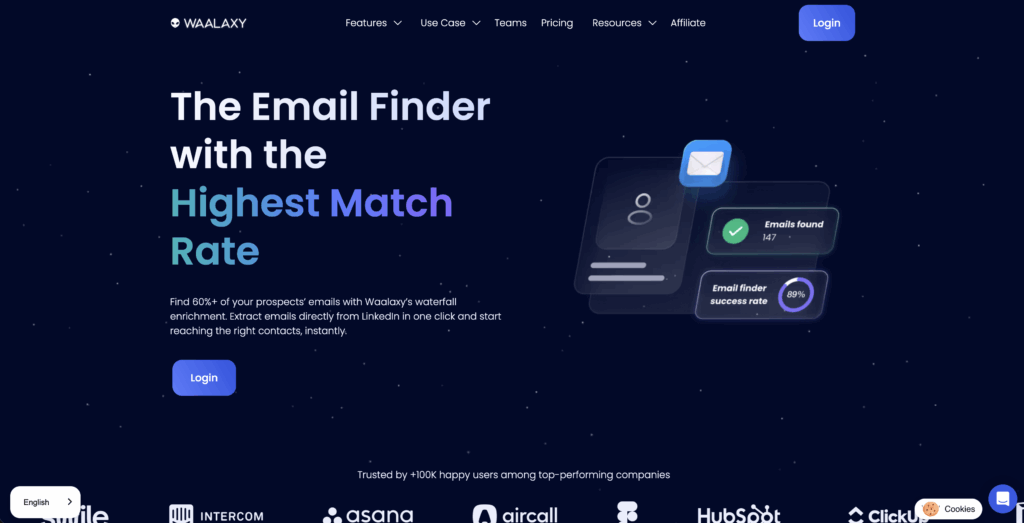
Waalaxy Email Finder, in figures:
– +60% more professional email addresses found on average with Email Finder,
– 15 data sources integrated into a single tool to enrich your lists (not just emails but also other useful information),
– Triple email verification (Dropcontact, Bettercontact, Fullenrich) for emails delivered at +99%.
Thanks to this tool, you can finally adopt a truly multi-channel approach without having to juggle between several tools.
4. Validate your list of prospect email addresses
It is often overlooked, but even with a good Email Finder, validating the list remains important before launching a campaign in order to:
- Remove duplicates,
- Eliminate invalid addresses,
- Remove generic domains such as “and” that are not very relevant.
- Avoid catch-all “” with too much uncertainty if your volume is high.
- Filter by country/sector/size if necessary.
- Check the overall deliverability of the campaign.
You can let the tool automatically check validity (bounces, syntax, MX, etc.) or run your prospect list through an external checker.

The goal is to have fewer bounces, thus improving your reputation as a sender, domain, and email deliverability, as well as achieving better long-term results by increasing your chances of landing in the inbox rather than in spam.
5. Launch the campaign after writing your emails with a CTA
Once you have chosen the sequence and prepared the list, it’s time to focus on the email content.
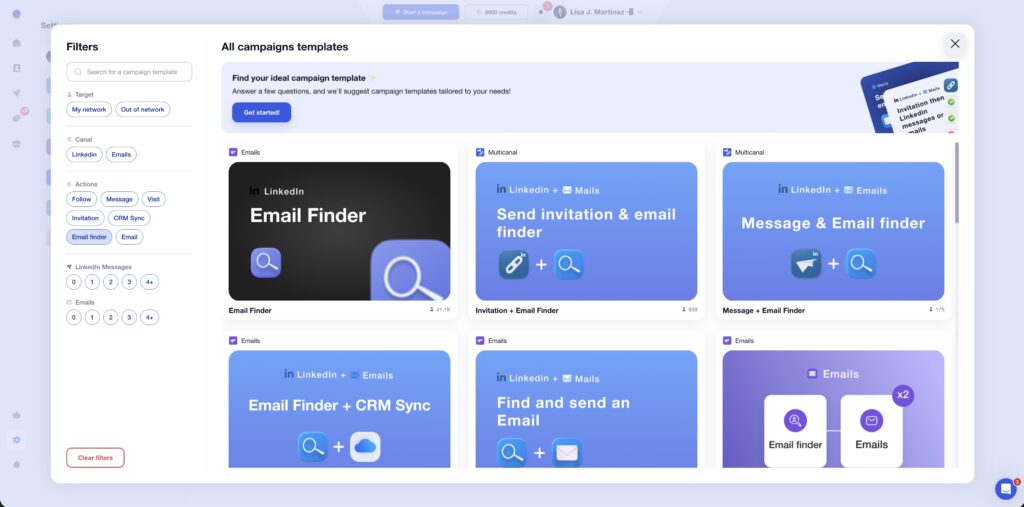
You can:
- Write your cold email templates directly in your cold email platform (take the opportunity to check that the personalization fields are filled in correctly and correct any formatting errors),
- Integrate personalized variables,
- Add a single clear CTA per email (see further on in the article for more information).
- Plan for at least two emails: an initial contact + a contextual follow-up 3–5 days later.
If you need inspiration, you can check out our prospecting and cold email templates that works.
A few things to check before clicking “Send”:
– Check that each cold sales email has a single objective with a clear CTA.
– Always add an unsubscribe link, which is mandatory for compliance and deliverability.
– Avoid being too aggressive in your subject lines/words (“FREE”, “EXCEPTIONAL OFFER”, etc.) and even in the CTAs you use (no “Let’s sign a contract” in the first email 😅).
– Comply with legal best practices in your emails (particularly GDPR in B2B in Europe).
Then, launch your first test campaign on a small scale, analyze the stats and adjust, then scale up. 🚀
6. Track and optimize your prospect emails
A campaign is not an “I send it and forget about it.” Once launched, the work is not over—it really begins.
Here are the performance indicators to track:
- open rate,
- click-through rate (CTR),
- response rate,
- conversion rate (appointments, demos, deals, etc.).
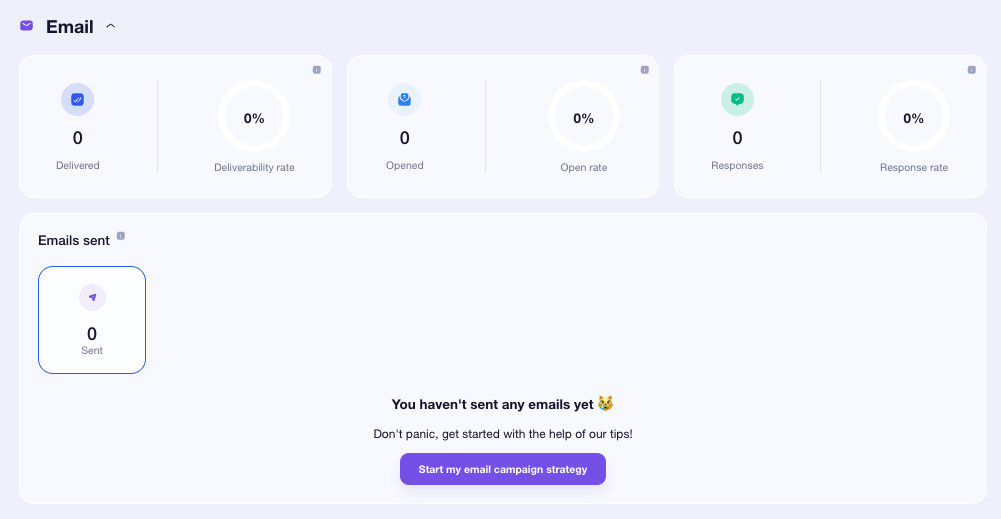
Based on these results, you can continuously optimize your campaign and your emails. To do this, there are two A/B testing tools available:
- Adjust the content
- 2 different subjects (long vs. short, question vs. benefit, with or without first name), as a simple change in subject can increase the open rate by +30%.
- 2 hooks,
- 2 CTAs,
- 2 structures, tones, or email lengths.
- Adjust the target, frequency, and timing
- Adjust your segments if certain ICPs respond better than others.
- Delays between follow-ups,
- Total number of emails,
- Sending times and days
- Pause or delete sequences that are underperforming.
Bonus: Launch your first cold email campaign
In summary, with these steps, you already have 90% of the structure of a professional campaign:
- Clear ICP,
- Prospects imported from LinkedIn,
- Well-designed LinkedIn + Email sequence,
- Validated list & configured email account,
- Targeted, simple, short, and personalized emails with CTA + unsubscribe,
- KPIs tracked + A/B testing.
And you can launch your first real campaign to establish new business relationships and generate more hot leads!
Of course, at first, the idea is not to “bombard”, so start with a first test.
- With a small volume (100-300 prospects) to see if your cold emails work.
- Avoid sudden spikes in volume (going from 0 to 1,000/day = 🚩), hence the need for an email warmup beforehand.
- How many cold emails to send per day? Do not send multiple cold emails per day to the same person; space out your emails by at least 1 day to 1 week.
Then adjust and gradually scale up. And above all, avoid common cold emailing mistakes! 😓
When you combine this with a series of automatic follow-ups, you end up with a very powerful lead generation engine.
How to write a successful cold email?
Now let’s look at the most sensitive part: writing the email.
Use this easy 5-step cold email prospecting guide to increase your chances of creating the best cold email ever through copywriting and technical optimization.
As a reminder, an effective cold email should be readable, personalized, and focused on the prospect, with a single clear objective.
Let’s get started! ⚡
Step 1: Optimize your email subject line
Your subject line is the first filter.
- It is what gives your prospect their first impression.
- It will determine whether the recipient opens the email or not.
- It must grab attention for the email to be opened.
- If it doesn’t make them want to click, the rest will never be read.
Here are a few principles to follow when carefully crafting an eye-catching B2B email subject line:
1. Keep it short: aim for ≤ 50 characters (maximum varies depending on the email service used) to get to the point.
| Webmail | Maximum number of characters in the subject line |
|---|---|
| gmail.com. | 77 |
| outlook.com. | 60 |
| laposte.net. | 45 |
| yahoo.fr. | 77 |
| orange.fr. | 30 |
2. Clear first, with key information or concrete benefits at the beginning of the sentence (promotion, event, deadline, etc.) to maximize the chances that the email will be read. Creative next, for example, through humor or a punchline.
3. Avoid spammy words that are monitored by email service providers: “FREE”, “URGENT”, “100% guaranteed”, etc.
4. Include personalization tags to make it more personal and pique curiosity: adding the first name or company name can increase your open rates.

5. Use emojis sparingly to make the subject line more visible or appealing (among the other emails piling up in the inbox): one or two at most, if it fits your tone.
Examples of cold email subject lines:
“{{FirstName}}, an idea to double your leads on LinkedIn”
“3 ideas to reduce no-shows for your demos”
“Quick question about your outbound prospecting.”
Test several subject lines in your campaigns to identify the best email style and what triggers the most opens among YOUR audience (including depending on desktop/mobile display).
Step 2: Write a cold email
The human attention span is decreasing at the same rate as technological advances that are changing our daily consumption habits.
Today, the majority of people now have a shorter attention span than goldfish. 🐠
Keep the email body brief/short to encourage your recipient to read an email from a stranger and easy to read to respect your prospects’ time.
How long should a cold sales email be? 2 to 5 sentences maximum, ideally between 80 and 150 words (max. 250 words).
Here is the classic structure for the body of a good cold email:
- Personalized hook/catchprase: reference to a post, podcast, role, current topic, or very specific problem.
- Context: introduce yourself, explain why you are contacting them now, and focus on a single action.
- Ultra-prospect-oriented value in body copy: objective and what you can bring them (results, gains, risk reduction) by getting straight to the point, without jargon or sales pitches,
- CTA to be added at the end of the text.
- Thank them for their time and say goodbye with a point of contact.
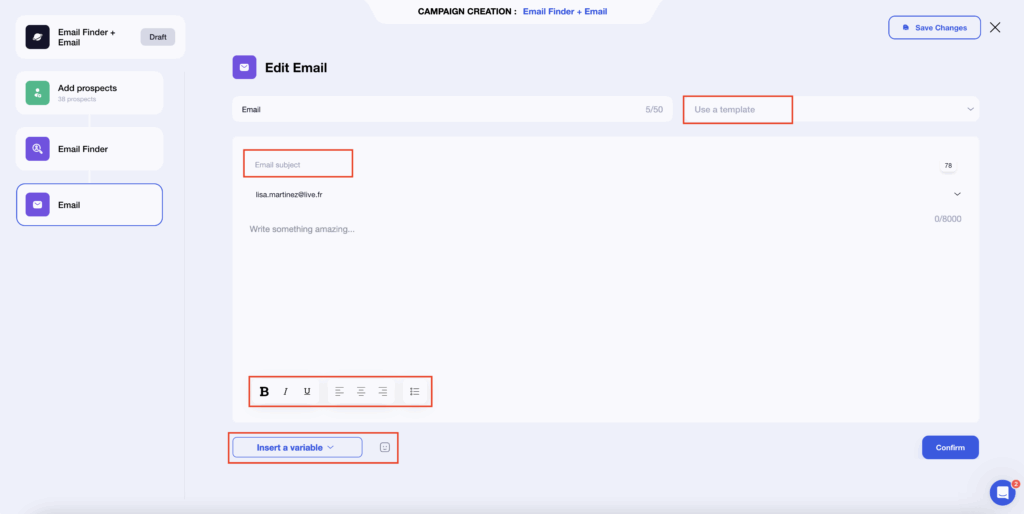
NB: Throughout the text, feel free to add your personal touch, as this can earn you points by setting you apart from the competition (you can also use AI to help you, but we do not recommend sending cold email AI).
Finally, as with objects, be sure to personalize certain passages using variables such as first name, last name, company, etc. It’s more important than you think. 😏
Cold email example:
Hello {{FirstName}},
I saw that you are responsible for {{responsibility}} at {{CompanyName}}, and that you are focusing heavily on {{channel/project}}.
We support similar teams in {{sector}} achieving {{result}} without any {{major objections}}.
If you’re interested, I can send you a concrete example or a mini 3-step plan tailored to {{CompanyName}}.
Interested?
Step 3: Add a call to action at the end of your cold emails
Without a CTA, even a good message falls flat.
A few golden rules for a good call to action (CTA) make “yes” easy and “no” OK too:
- Only one CTA per email,
- Often placed towards the end,
- Simple/basic action requested, consistent with the prospect’s maturity, easy to execute (short reply, choice, etc.),
- Emphasizing the benefit to persuade,
- Maximum one sentence with an action verb in the present imperative to make the subject of the email and the action to be taken clear,
- Avoid using it in the first email so as not to put pressure on the prospect (they don’t owe you anything); remember that the goal at this stage is just to get a response.
Examples of effective cold email call to action:
“Available for a quick 10-minute chat this week?”,
“Just say “OK” and I’ll share the template with you”,
“Reply to this email”,
“Book a slot”,
“See a concrete example,”
“Sign up for the newsletter”,
“Become a member,”
“Summary in 3 points,”
“Watch the demo video,”
Etc.

With Waalaxy, you can enrich your email subjects, bodies, and CTAs with:
- Dynamic variables ({{FirstName}}, {{CompanyName}}, {{Role}}, etc.),
- Clean hyperlinks,
- Light formatting (bold, lists, line breaks) to improve readability.
- Automatically insert a signature in all your emails.
- Preview your emails before launching the campaign.

Step 4: Pay attention to the cold email signature
The signature is often overlooked.
Yet it is a very important element that should reassure, lend credibility, and provide points of contact:
- Show your recipients who you are and where they can learn more about you or your organization. 🤩
- Help condense the body of the email, making it more digestible and more recipient-focused (if it is well written). 💗
A good signature should:
- Be truthful and inspire confidence,
- Clearly indicate who you are (name, role),
- Include a link to schedule an appointment (Calendly, etc.) or contact information,
- Mention your company and possibly a link (website/LN),
- Keep it light (no 3 logos, 5 badges, 10 links, no huge images or quotes…), don’t add elements that take up space without providing information,

“⚠️ If you are unsure about your HTML, use a plain text signature rather than an HTML signature to avoid deliverability issues. It is better to have a simple, readable signature than a pretty, filtered one”.
You can create your own email signature for free (clean and deliverability-compatible) with our Waalaxy email automation tool!
You can reuse them and automatically insert them into your cold email templates to maintain a consistent identity across all your campaigns. 👽
Step 5: Follow-up email campaign
Even a well-written cold email may not be enough to pique your prospects’ interest; they may not see it, or they may see it but not respond.
Nowadays, a single email is no longer enough to get a response (they often come… after a follow-up).
That’s why you should always follow up and include follow-up emails in your campaign (1 to 3 reminders max)!
- First email: opening the conversation.
- Follow-up 1 (D+3 to D+5): short, contextualized (“, I’d like to quickly remind you”),
- Follow-up 2 (D+7 to D+10): alternative, different angle or other resource,
- Possibly a final follow-up “soft close” (you could try using humor).
They must add value to your initial email (case study, invitation to a webinar, direct question, etc.) in order to convince them to respond.
Example of a short follow-up:
“Hello {{FirstName}},
I’m following up on my previous email about {{subject}}.
If it’s not a priority, no worries. But if the topic of {{bread}} is on the table at {{CompanyName}}, I can share a concrete example that could save you time.”
But managing all of this manually on a large scale is a nightmare 🥵: emails and personalized follow-up emails, follow-ups, replies… (I’ve been there, done that).
Fortunately, with today’s cold email tools like Waalaxy, you can save considerable time on your campaigns:
- Start from LinkedIn,
- Enrich emails with Email Finder,
- Automatically follow up LinkedIn messages + cold emails while respecting limits,
- Automate email sending only and add follow-up emails if there is no response to the first email. 🏃
- Filter prospects and launch another campaign in parallel to respond to those who replied and are therefore interested,
- Perform A/B testing on sub-segments.
- Manage tracking for all of this in a single dashboard.

Bonus 1 – When to send cold emails?
Timing isn’t everything… but sending emails at the right time can help you get good response rates.
To choose the best time to send cold emails, there are two variables to keep in mind:
In B2B, the time slots that work best and significantly increase the chances of being read are:
- between 9 a.m. and 11 a.m.
- or early afternoon (1pm–3pm).
Avoid:
– Sending emails in the middle of the night (they will almost automatically appear in spam).
– Sending on Friday at 6 p.m. or Monday at 8 a.m. (full inbox + no priority).
The most effective days are generally Tuesday and Thursday (especially if targeting business leaders or qualified experts).
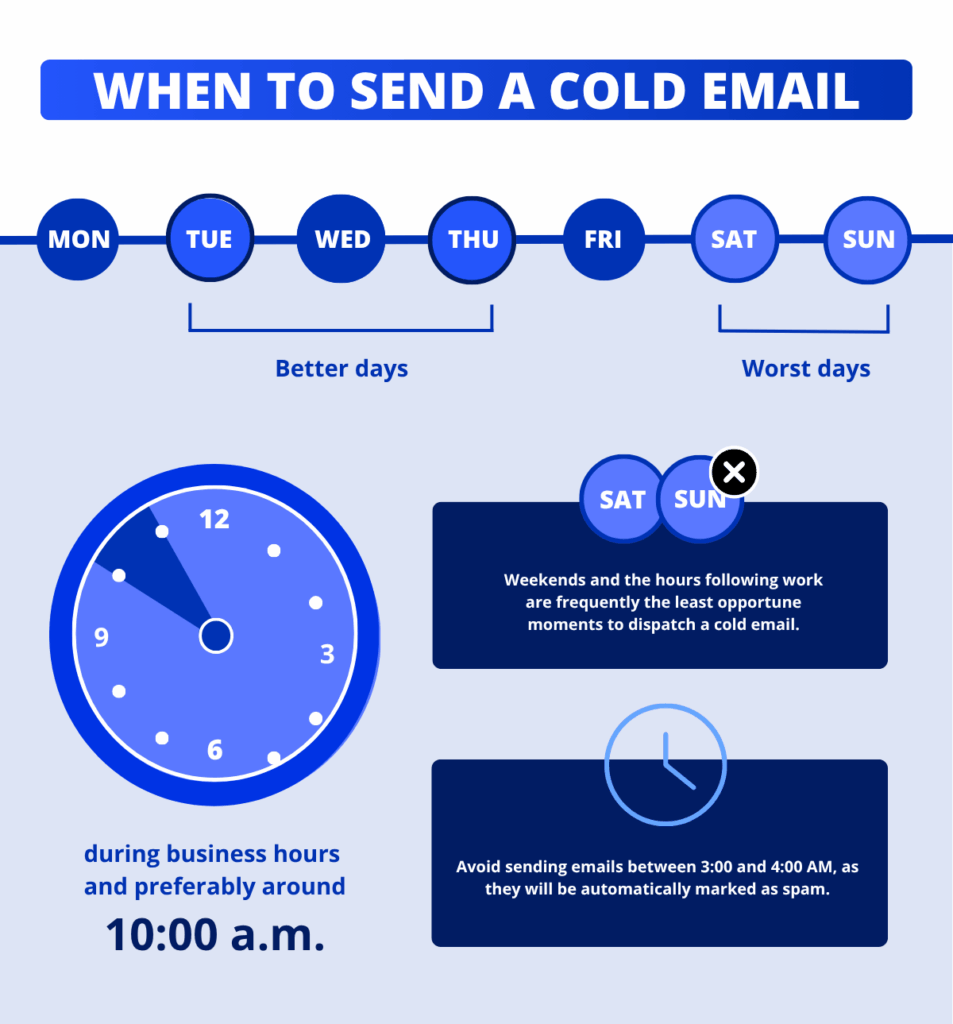
But the most important thing is to test on YOUR audience, then settle on the slots that perform best.
Bonus 2 – How to get responses to a cold email?
A cold email should be brief but impactful in order to get responses. Therefore, every element mentioned should be meaningful and serve an important purpose. 🗣️
But we know that even if you’re a pro at copywriting and automation, it may not be enough to get responses…
According to Waalaxy, here’s what influences whether a message will have a high response rate and what to do to maximize responses:
- Test your emails with a preview before sending,
- Send a few test emails to your own inbox/a small internal panel,
- Monitor the signals on your outbound campaigns:
- Lots of opens but few responses → message/CTA problem,
- Few opens → subject line/deliverability issue.
The more you measure, the more you adjust, the less your cold emails will be “cold.”
Measuring cold email metrics
You can’t optimize what you don’t measure.
You can easily find areas where you can improve by prioritizing three KPIs.
The recommended performance levels should be checked and adjusted according to the averages for your industry (see MailChimp’s benchmark).

What is a good cold email open rate?
In B2B, a good email open rate is often around:
- ≥ 25%: acceptable,
- ≥ 35–40%: very good.
If your open rates are too low, set reasonable goals for your next email campaign:
- Revise the subject lines,
- Check deliverability (domain, warm-up, spam score),
- Check that your lists are well targeted.
However, adding the recipient’s name to the subject line can increase the open rate by 22.2%! 🛩️
But be careful, looking only at the open rate can be misleading! Also take into account the response rate of your cold emails.
What is a good cold email reply rate?
The average response rate for cold emails can be around 1% for generic, poorly targeted campaigns.
But you can aim for 5 to 15% responses, or even more on certain ultra-specific segments, with:
- A good ICP,
- Good copywriting,
- A good sequence,
It’s hard to say what a good response rate is, as it mainly depends on the goals of your cold email campaign, as well as your audience, industry, and expertise. But keep in mind that if your response rate is about half your open rate, you’re doing well. 🎉
The important thing:
- Compare your campaigns with each other.
- Analyze what works (sector, position, tagline, CTA),
- Capitalize on it.
You can find out how to increase your acceptance rate to 51% and your response rate to 14.5%! 💥
What is a good CTR (Click-Through Rate) for cold email?
The CTR measures the percentage of people who click on a link in your email. This is useful if your goal is to:
- Resource download,
- Page visit,
- Appointment booking via link.
Some key figures:
- CTR of 2–3%: OK,
- 5–10%: very good.
If your CTR or click-through rate is low even though your open rates are good:
- Make sure there aren’t 15 parasitic links.
- Simplify your emails.
- Make the link more prominent (clear call-to-action, position, wording),
In short, in addition to monitoring, it is essential to understand what the data is telling you so that you can respond appropriately.
With all these tips, I’m sure you’ll be ready to launch your first cold email campaign successfully! 🚀
Conclusion: How to Cold Email for Lead Generation?
Cold emailing works like an opportunity-generating machine…if you use it with the right intention.
It can be used to generate leads, get more appointments, develop your network, secure partnerships, obtain backlinks, or even approach talented individuals.
It always works according to the same pattern:
- Identify your ICP,
- Find email and enrich their contacts (LinkedIn + email),
- Send a short, personalized, value-oriented sequence,
- Follow up on responses and turn conversations into opportunities.
For a cold email to work and turn contacts into leads, focus on:
- Authenticity: you don’t want to sound like everyone else, but rather attract attention and encourage people to read the email.
- Trust: you’re a stranger, so you need to highlight specific facts to gain the trust of your potential customers.
- Short, clear messages: the goal is not to sound like Shakespeare.
- Personalization to develop a relationship (the sale takes a back seat).
- A real value proposition (not an aggressive pitch): people need to understand the value before they understand why they should get it.
It’s not a magic channel… but when used well, it’s a reliable, scalable, and extremely powerful acquisition engine to accelerate your B2B growth.
I hope these suggestions will help you create brilliant and effective cold emails. Good luck! 🍀
Frequently Asked Questions (FAQ) About How to Cold Email?
Is cold emailing illegal? Focus on GDPR
In B2B, commercial cold emailing is not illegal… provided that a few rules are followed:
- Only target professional email addresses.
- Target people for whom your proposal is relevant (legitimate interest),
- Include a clear and functional unsubscribe link (opt-out).
- Do not harass (limit frequency, stop if requested).
On the other hand, contacting personal addresses without opt-in is highly regulated—even prohibited in some contexts.
The GDPR framework requires transparency, data minimization, and respect for the right to object.
Writing cold emails in 5 steps
In summary, to write the best cold emails for your online sales prospecting, you need to follow these 5 steps:
- Work on the subject line, as it is the first impression your contact will have of you: keep it short, clear, and personalized.
- Add a personalized hook: show that you are not contacting 10,000 people with the same text.
- Get straight to the point: explain in one or two sentences what you can offer and/or how you can solve their problem.
- Formulate a simple CTA: a question, a yes/no, or a mini call.
- Pay attention to the format:
- short sentences,
- 80–150 words max,
- professional signature (helps avoid ending up in spam folders),
- human tone (not a sales robot).
- personalized emails with the recipient’s name from the very first email,
- Follow up with your contacts to keep the conversation going and not miss out on business opportunities.
Remember, a good cold email strategy without good copywriting or storytelling is just noise.
How do you set up the opt-in?
”B2B cold emailing is based on legitimate interest“, not on traditional marketing opt-in. In other words, you can contact a professional email address if your message is relevant to the role/company.
On the other hand:
- As soon as someone shows interest (positive response, registration, resource download, etc.), you can include them in your email marketing campaigns, provided you clearly inform them of this.
- If you collect emails via a form, make sure that consent is explicit (double opt-in):
- Checkbox,
- Text explaining what the person will receive (frequency, type of content).
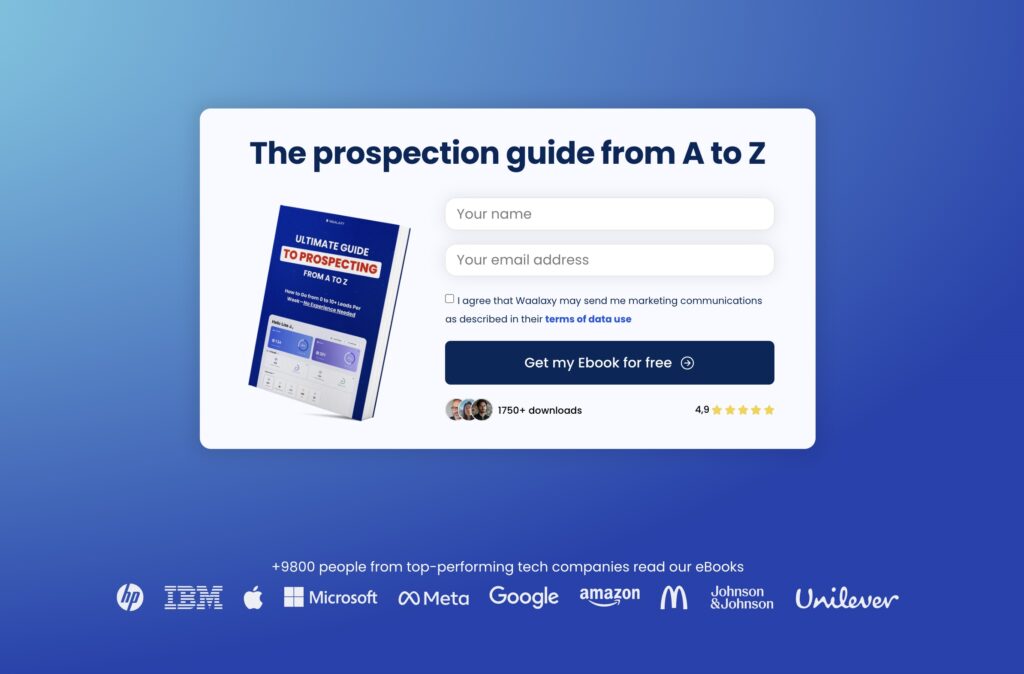
Do not mix (even if the two complement each other):
- Cold emails that open doors (outbound, prospecting, initial cold contact),
- Email marketing that develops and maintains relationships (newsletters, nurturing sequences, automated post-opt-in campaigns).
And above all, on the opt-out side (a mandatory practice that allows you to easily unsubscribe at any time) 💯:
- Always add a clear unsubscribe link in your cold emails (or an explicit sentence such as “, reply STOP to stop receiving messages”),
- Process unsubscribe requests immediately: do not follow up, do not re-import the person into other lists,
- Consider opting out as a sign of respect: it is better to have a smaller, but engaged, database than an inflated and annoyed one.

Alternatives to cold emailing
Cold emailing is powerful, but it is only one channel among many. You can (and should) combine it with:
- LinkedIn: private messages, comments, personalized connection requests, content.
- Phone: excellent as a follow-up after 1–2 emails, especially in mid/enterprise.
- Webinars & events: to generate leads and then follow up by email.
- Social media (X, Instagram, TikTok depending on your audience).
- Referrals & recommendations: activate your current customers.
- Blogs & forums: content + outreach from readers/subscribers.
- Website: forms, lead magnets, chat, etc.
Multiple points of contact = more chances to build a relationship.
Now you know whats a cold email and how to send cold email to cold contacts. Follow our advice and use the templates provided in this article. See you soon! 👋🏼


